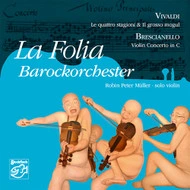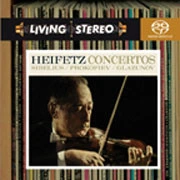Hybrid SACD 2-Channel / 4.0 Surround Sound!
LA FOLIA - in the Baroque era this term stood for boldness, wild passion, boisterousness, welcome distraction and altogether meant an artistic attitude of liberty and excessive creativity. Ever since its founding in 2007 La Folia Barockorchester has, on period instruments, stimulated the international music scene with these same attributes and is known for causing a furore in the best possible way.
La Folia Barockorchester is counted among the most fascinating ensembles from the Early Music Scene.
Be it as a chamber music ensemble or with performances in full Baroque sumptuousness, be it instrumental music or collaborations with vocal soloists this young ensemble, with its founder and concert master Robin Peter Müller, stands for lively and rousing interpretation of music from the 17th and 18th centuries. As historically informed musicians, they are always looking for ways to transport emotions and meanings of past centuries to be experienced by modern audiences. Vividness and enjoyment of playing, but also respect for the music and awareness of its intensive effect these views of the Baroque era build the foundation of La Folia Barockorchesters interpretations.
A.Vivaldi: Le quattro stagioni:
This venturesome, sometimes sharp-edged, but in any case expressive new recording of the Quattro stagioni by La Folia Barockorchester offers perhaps a chance to see Vivaldi's masterpiece in a new, somewhat contemporary light. It gives us something to think about, makes us examine the relation between humans and nature: Europe suffered from a Little Ice Age between the 15th and the 18th centuries, whose economic, political, and cultural consequences still remain to be examined. Among other things it brought extreme cold spells to usually mild climatic zones. Thus the lagoon in Venice froze over, for example in the winter of 170809. It was probably this particular event that Vivaldi referenced in his concerto known as Winter.
G.A. Brescianello (ca. 1690-1758): Violin Concerto in C Major:
In 1738 a collection of six concerts and six symphonies was published in Amsterdam. These works found their way to the Dresden Court in the same year, just like the Violin Concerto in C major, which is recorded here for the very first time. What stands out most of all is the close interlinking of the solo violin with the tutti, which is especially apparent with a solo line-up for the orchestral parts, as in the present recording. Brescianello causes the solo violin and the first tutti violin to circle each other and to develop joint phrases like a playful and sometimes flirtatious conversation.
A.Vivaldi: "Il grosso mogul" Violin Concerto in D Major RV208:
We have to imagine Venice as a centre of early modern globalization: Just like a lens, this city concentrated the different aspects of the world, be they cultural, economic, ethnic or religious. And Venice is swaying. In dealing with strangers the zeitgeist swings between fear and fascination. In the end it is this horizon that provides the setting for the Violin Concerto in D major Il grosso mogul.
It is a violin concerto that shattered the limits of the contemporary with its structure-dissolving form, its burning emotions especially in the first movement, its exotic enrichment of melodics and harmonics, the unusually long phrases, the vertiginous technical requirements, and unaccompanied passages overflowing with almost provocative egotism in the solo part.
The "Palais im Grossen Garten" in Dresden:
is said to be one of the earliest Baroque buildings in the German-speaking world. It was originally built as a summer residence in 1680. The recordings for this album took place in the banquet hall of Palais im Grossen Garten. It stands out for its lively sound and enables the musicians to hear each other perfectly. The length of the reverb lies between 3 and 4 seconds. In particular, high frequencies fade out elegantly and the reflections of the room are blended with the instruments, which is a perfect setting for recording chamber music.
SACD surround Sound requires multi-channel SACD player and compatible surround sound system for playback. SACD Stereo requires SACD player. This Hybrid Disc contains also a CD player playable on any standard CD player.
Features:
Super Audio CD
SACD 4.0 Multi-Channel SACD Layer
SACD Stereo SACD Layer
This Hybrid SACD contains a 'Red Book' Stereo CD Layer which is playable on most conventional CD Players!
Release Date: April 1, 2015
Musicians:
La Folia Barockorchester
Robin Peter Muller, solo violin
Selections:
Antonio Vivaldi (1678-1741)
Le Quattro Stagioni (The Four Seasons)
La Primavera (The Spring)
1. Allegro
2. Largo e pianissimo
3. Allegro
L'Estate (The Summer)
4. Allegro ma non molto
5. Adagio
6. Presto
L'Autunno (The Autumn)
7. Allegro
8. Adagio molto
9. Allegro
L'Inverno (The Winter)
10. Allegro non molto
11. Largo
12. Allegro
G.A.Brescianello (ca. 1690-1758)
Violin Concerto in C Major
13. Allegro
14. Largo
15. Allegro assai
Vivaldi
Violin Concerto in D Major RV 208
Il grosso mogul
16. Allegro
17. Grave
18. Allegro
Total playing time, 62:02
LA FOLIA - in the Baroque era this term stood for boldness, wild passion, boisterousness, welcome distraction and altogether meant an artistic attitude of liberty and excessive creativity. Ever since its founding in 2007 La Folia Barockorchester has, on period instruments, stimulated the international music scene with these same attributes and is known for causing a furore in the best possible way.
La Folia Barockorchester is counted among the most fascinating ensembles from the Early Music Scene.
Be it as a chamber music ensemble or with performances in full Baroque sumptuousness, be it instrumental music or collaborations with vocal soloists this young ensemble, with its founder and concert master Robin Peter Müller, stands for lively and rousing interpretation of music from the 17th and 18th centuries. As historically informed musicians, they are always looking for ways to transport emotions and meanings of past centuries to be experienced by modern audiences. Vividness and enjoyment of playing, but also respect for the music and awareness of its intensive effect these views of the Baroque era build the foundation of La Folia Barockorchesters interpretations.
A.Vivaldi: Le quattro stagioni:
This venturesome, sometimes sharp-edged, but in any case expressive new recording of the Quattro stagioni by La Folia Barockorchester offers perhaps a chance to see Vivaldi's masterpiece in a new, somewhat contemporary light. It gives us something to think about, makes us examine the relation between humans and nature: Europe suffered from a Little Ice Age between the 15th and the 18th centuries, whose economic, political, and cultural consequences still remain to be examined. Among other things it brought extreme cold spells to usually mild climatic zones. Thus the lagoon in Venice froze over, for example in the winter of 170809. It was probably this particular event that Vivaldi referenced in his concerto known as Winter.
G.A. Brescianello (ca. 1690-1758): Violin Concerto in C Major:
In 1738 a collection of six concerts and six symphonies was published in Amsterdam. These works found their way to the Dresden Court in the same year, just like the Violin Concerto in C major, which is recorded here for the very first time. What stands out most of all is the close interlinking of the solo violin with the tutti, which is especially apparent with a solo line-up for the orchestral parts, as in the present recording. Brescianello causes the solo violin and the first tutti violin to circle each other and to develop joint phrases like a playful and sometimes flirtatious conversation.
A.Vivaldi: "Il grosso mogul" Violin Concerto in D Major RV208:
We have to imagine Venice as a centre of early modern globalization: Just like a lens, this city concentrated the different aspects of the world, be they cultural, economic, ethnic or religious. And Venice is swaying. In dealing with strangers the zeitgeist swings between fear and fascination. In the end it is this horizon that provides the setting for the Violin Concerto in D major Il grosso mogul.
It is a violin concerto that shattered the limits of the contemporary with its structure-dissolving form, its burning emotions especially in the first movement, its exotic enrichment of melodics and harmonics, the unusually long phrases, the vertiginous technical requirements, and unaccompanied passages overflowing with almost provocative egotism in the solo part.
The "Palais im Grossen Garten" in Dresden:
is said to be one of the earliest Baroque buildings in the German-speaking world. It was originally built as a summer residence in 1680. The recordings for this album took place in the banquet hall of Palais im Grossen Garten. It stands out for its lively sound and enables the musicians to hear each other perfectly. The length of the reverb lies between 3 and 4 seconds. In particular, high frequencies fade out elegantly and the reflections of the room are blended with the instruments, which is a perfect setting for recording chamber music.
SACD surround Sound requires multi-channel SACD player and compatible surround sound system for playback. SACD Stereo requires SACD player. This Hybrid Disc contains also a CD player playable on any standard CD player.
Features:
Super Audio CD
SACD 4.0 Multi-Channel SACD Layer
SACD Stereo SACD Layer
This Hybrid SACD contains a 'Red Book' Stereo CD Layer which is playable on most conventional CD Players!
Release Date: April 1, 2015
Musicians:
La Folia Barockorchester
Robin Peter Muller, solo violin
Selections:
Antonio Vivaldi (1678-1741)
Le Quattro Stagioni (The Four Seasons)
La Primavera (The Spring)
1. Allegro
2. Largo e pianissimo
3. Allegro
L'Estate (The Summer)
4. Allegro ma non molto
5. Adagio
6. Presto
L'Autunno (The Autumn)
7. Allegro
8. Adagio molto
9. Allegro
L'Inverno (The Winter)
10. Allegro non molto
11. Largo
12. Allegro
G.A.Brescianello (ca. 1690-1758)
Violin Concerto in C Major
13. Allegro
14. Largo
15. Allegro assai
Vivaldi
Violin Concerto in D Major RV 208
Il grosso mogul
16. Allegro
17. Grave
18. Allegro
Total playing time, 62:02

 Turntable Accessories
Turntable Accessories Headphone Accessories
Headphone Accessories Cable Accessories
Cable Accessories Vinyl Accessories
Vinyl Accessories Compact Disc Accessories
Compact Disc Accessories







